While a bit of rain on a short run isn't really any trouble, if you're running further, or it's both cold and wet, then a waterproof running jacket can be a saviour.
But which jacket should you pick? To help you make that decision, we’ve tested a total of 13 running jackets split between both men and women.
But before we get to the reviews, let’s talk about what we tend to look for…
What should I look for in a waterproof running jacket?
The first question must focus on how the jacket will be used and what your specific needs are.
If you run hot while exercising, you’re not going to want anything too stuffy, but rather something with decent breathability and ventilation.
You can easily layer up with warmer base layers underneath, too, so you don't need to worry about getting any warmth from your waterproof running jacket. That way, you can add or remove layers as you get cold or hot.
So what should you look for when choosing a waterproof running jacket? Well, first and foremost, it needs to keep the weather out. Read more about that in the next section of this article.
Given the nature of running, a good jacket will also be breathable or allow you to ventilate and regulate your temperature. To that end, vents, mesh-lined pockets and breathable fabrics can be a godsend.
Hoods are down to personal preference, but if the jacket has one we like it to fit close to the head so it doesn’t blow around. If you can roll it down and fasten it away, even better.
We also like to see elasticated cuffs, a close-fitting hem (often aided by adjustment points), hi-vis detailing and a pocket for essentials (though this is less important if you use a pack/belt while running).
That aside, it also has to fit well so it doesn’t catch the wind, otherwise it can feel like a parachute on really breezy runs.
Weight and pack size is key so you can stow your jacket away if it stops raining or you overheat, while we also like it to look good – obviously!
Of course, you may just want something super lightweight to chuck in a pack as mandatory kit at a race – just make sure you check the requirements for your race first, as some races will stipulate taped seams and a minimum hydrostatic head rating.
What makes a jacket waterproof?

Most waterproof running jackets will use either a waterproof membrane, a durable water repellent (DWR) coating or a combination of both.
That membrane is usually bonded to the inside of the jacket, which will form part of a two or three layer (or sometimes 2.5 layer) system. Often, these membranes are provided by a third-party company such as Gore-Tex (widely regarded as industry leaders) eVent and Pertex.
DWR coating
Brands typically then apply a DWR coating to the outside to ensure water beads up on the surface of the jacket.
The DWR coating will wear away over time, particularly when it gets dirty or is faced with a lot of abrasion, such as from a running pack.
When that happens, the outer fabric may 'wet out'. That means that water soaks into the fabric on the outside of the jacket, though doesn't go through the membrane (if the jacket in question has one). As a result, the jacket can start to feel cold, heavier and breathability can suffer.
To avoid this happening, DWR coatings needs to be reapplied periodically with a special wash or spray, such as Nikwax or Grangers.
For a jacket to be truly waterproof, its seams need to be sealed. This typically comes in the form of taped seams, which stop any water from passing through.
Hydrostatic head
When looking at waterproof running jackets, you'll probably see a figure (in millimetres) quoted in the product description. That's probably the hydrostatic head (sometimes written as HH), which measures how waterproof a fabric is.
To be classed as waterproof, a fabric should have a minimum rating of 1,500mm, though most waterproof kit will typically have hydrostatic head ratings of 5,000m upward, and most waterproof jackets will have a rating of 10,000mm. That last figure is a good benchmark when searching for your jacket.
What about zips?
One final note... due to the very nature of them, zips are rarely described as 100% waterproof. Many utilise DWR coatings and waterproof materials in their construction, and do a fine job of keeping the elements out, but they can still be a weak point in weather protection when in particularly bad conditions.
As such, we like to see a storm flap behind the zip to protect against any water ingress.
Not fussed about having a jacket that's 100% waterproof? Check out our list of the best running jackets for options that offer less protection against the rain, but may be suited to your needs.
Best waterproof running jackets for men
Montane Spine Jacket
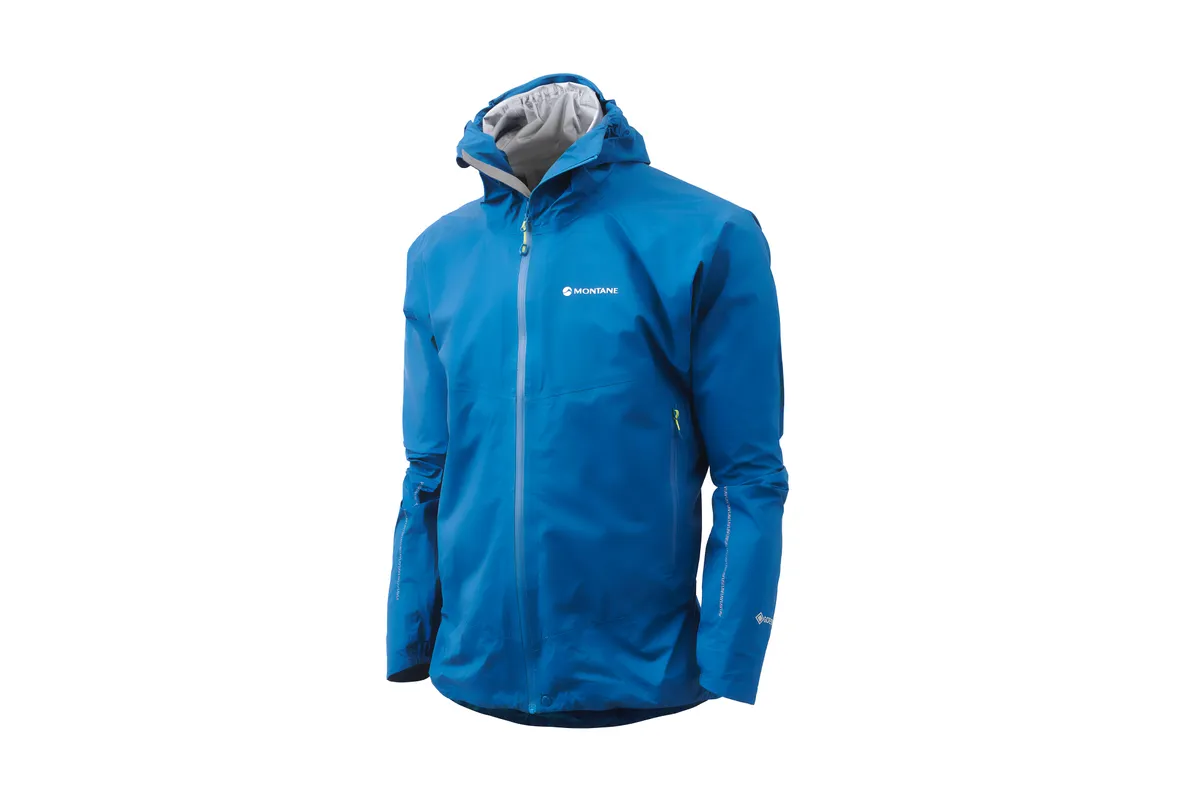
- £250
This is the most expensive jacket by quite some margin, but you get a fully-featured piece of kit for your cash. There’s an adjustable, wire-peaked hood, two waist adjustments and two mesh-lined pockets.
This, and the inclusion of Gore-Tex Active, all adds up to a weight of 245g (UK size medium). That being said, it also makes this the best jacket in sustained and heavy rain. The inclusion of a waterproof membrane means it’s not the most breathable, but the mesh-lined pockets help with ventilation.
There’s also a press-stud clip that sits behind the zip, which allows you to wear the jacket with the zip undone, thus boosting ventilation. Meanwhile, reflective detailing helps with visibility.
Verdict: A reliable jacket that's great in bad weather
Score: 93%
Scott RC Run WP
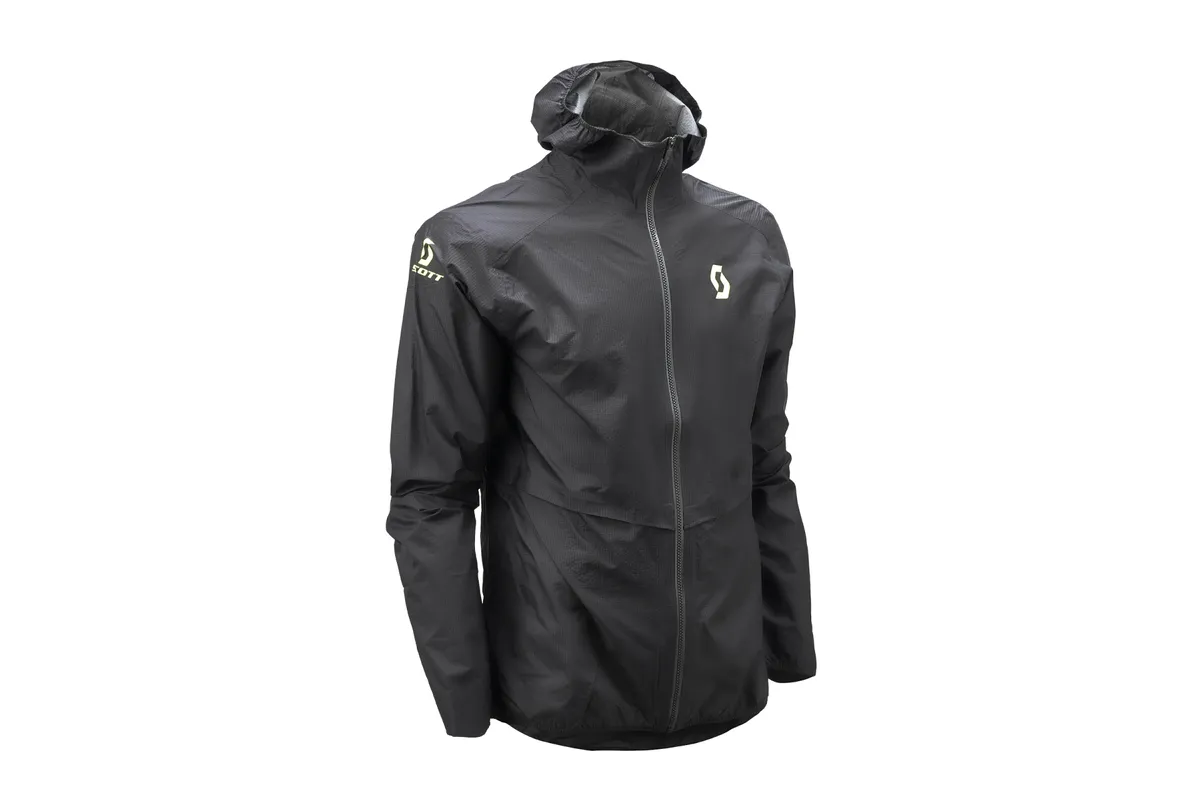
- £180
Scott’s RC Run shares a lot of similarities with the Rab Phantom. It’s lightweight (120g, UK large), packable and uses Pertex Shield and taped seams for its weather proofing. As a result, weather protection is similarly impressive.
The hood is similar, too, using elasticated edges to achieve a good, close fit. Though there’s no wired peak here, it still does its job well.
So what about the differences? Well, there’s a full-length zip, but this doesn’t use a waterproof zip guard on the inside, so you may find a little water ingress in sustained heavy downpours.
The other big difference is that Scott has added a series of vents to the front and back of the garment to help provide ventilation and temperature regulation. It’s a nice touch, particularly if you tend to run hot like this tester, and we noticed minimal water ingress here during testing.
An elasticated hem and cuffs help keep the elements out, but note that the fit is close, so you may want to size up.
Verdict: Top performance and ventilation, but watch out for sizing.
Score: 85%
Asics Fujitrail

- £208
It’s immediately clear that the Fujitrail is built by runners, for runners. There are two bright colourways (plus black) to help you stand out and a great set of features.
These include drawstring toggles at the hem, an integrated stuff sack, a waterproof zip pocket on the chest that’s large enough for a phone, elasticated cuffs with thumb hooks and a fully adjustable hood.
The latter has three points of adjustment, allowing you to get a close fit, but you can’t mould the hood’s peak to your liking.
Another feature we loved was the press stud across the chest behind the zip. This allows you to clip the jacket together while leaving it unzipped, helping provide ventilation while still keeping the worst of the rain off.
Speaking of which, the jacket uses a Pertex Shield fabric and fully-sealed seams to provide its weather proofing, which worked well in downpours. The jacket is also lightweight (173g, UK size large) and stashable, but all this does come at a cost.
Verdict: Everything a waterproof running jacket should be.
Score: 90%
Rab Phantom Pull-on
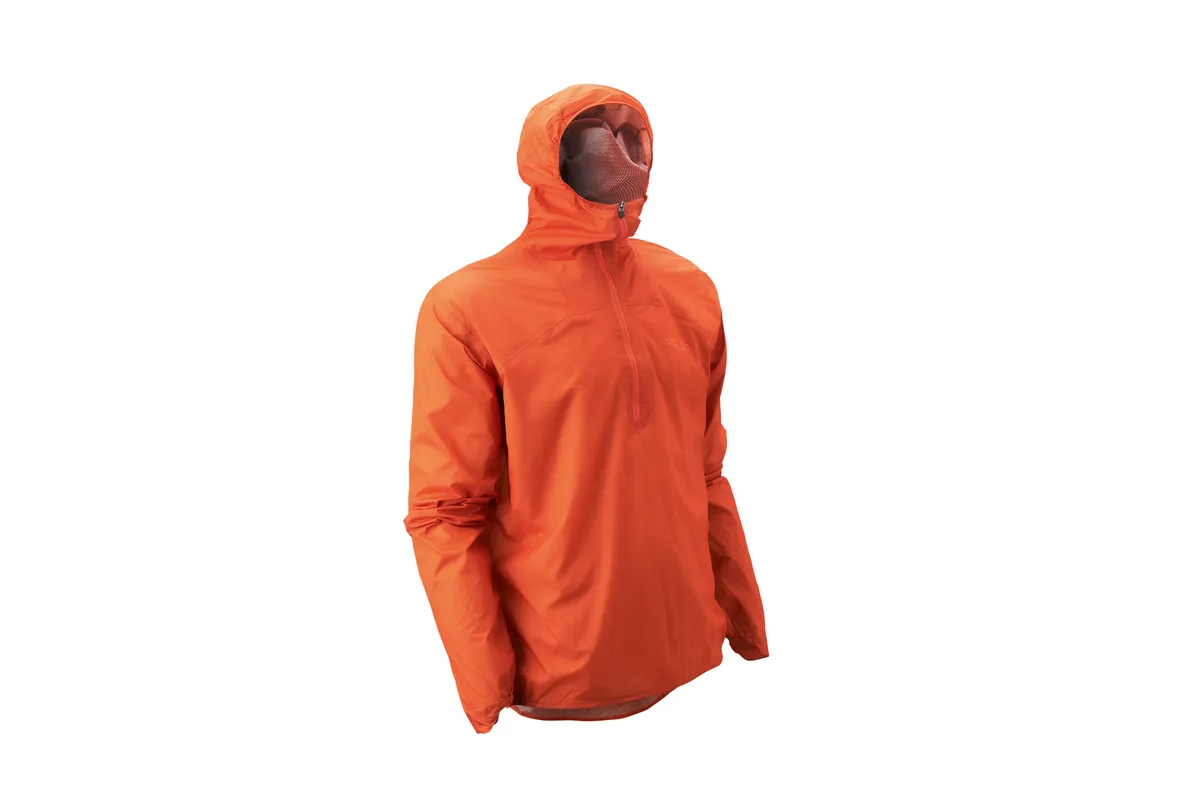
- £160
British outdoor brand Rab only entered the running market recently, but they’ve been making brilliant waterproof jackets for years.
In the Phantom we have a pared back, ultra-lightweight (89g, UK size medium) garment that packs down into a stuff sack that’s comparable to the size of an avocado. That makes it a great option for racing, when you don’t anticipate poor weather but need to bring something along just in case.
The lightweight nature of the jacket means there are limited features. There are no pockets or adjustments on the hem, but the latter is elasticated and keeps the elements out well.
The cuffs are also part elasticated, keeping weather out but allowing easy access to your watch. The only adjustment on the elasticated hood is a malleable peak, but the design means this part of the jacket actually fits nice and close.
Like Asics, Rab uses a Pertex Shield fabric here, which offers similar levels of breathability and waterproofing.
Verdict: A superb and reliable lightweight option that's ideal for racing.
Score: 88%
Soar Ultra 4.0

- £210
Soar specialises in high-end running gear, with garments often commanding a high price tag, and that’s the case here.
The brand describes this as your ‘go-to jacket for all but heavy rain’ and in testing it shed water well.
There’s no membrane – instead, Soar applies a DWR coating to both the yarn and the finished fabric. The result is that this is the most breathable jacket on test. Yes, you’ll need to reproof it periodically, but you have to do that with most waterproof jackets anyway.
Features are also impressive. There’s no hood, but the collar fits closely, while an adjustable hem works well down below.
The cuffs are also elasticated, while a roomy zip pocket at the rear is handy for essentials but does bounce around a bit more than a chest pocket would.
It’s not the lightest (195g, UK medium) or most packable on test, but it’s not far behind the best.
Visibility is also boosted with reflective strips, while the jacket is also available in yellow and mint green.
Verdict: Unrivalled breathability and good features, but not cheap.
Score: 86%
Odlo Dual Dry

The Odlo is easily the most expensive here, with the 135g weight of the Dual Dry material coming in at £1.63 per gram, close to Iberico ham prices.
So, will the ISPO-award winning Dual Dry have us (we’re sorry) squealing in delight? There’s no escaping that this is a serious rain jacket, with taped seams and a 20,000mm waterproof rating ensuring serious aqua thwarting.
Once stashed in the pocket, it’s quite hard to undo at speed, yet the adjustable hood with peak stays stubbornly in place (and stretchy hems on the sleeves and waists help prevent draughts sneaking in).
The waterproof pocket and hi-vis details add further appeal, as does the translucent material’s breathability, but whether this is £220-good will depend on your pay packet.
Verdict: A mighty jacket but there’s no avoiding that price tag.
Score: 80%
Best waterproof running jackets for women
Inov-8 Stormshell

- £180
Weighing only 140g and extremely waterproof, the Stormshell features the kind of quality you would expect from a brand based in the fells and using some of the UK’s toughest conditions as their test bed.
Once on, this was the easiest jacket on test to forget about, fitting well and feeling barely-there. Once the heavens opened it proved its worth, though, keeping us bone dry yet not at all clammy.
The light weight and packability (it packs down inside its own zippy pocket) also made it the easiest to stash in our trail pack and forget about until needed.
The peaked hood includes a wire for adjustability as well as a cord to draw it in, plus there’s a waterproof zip with storm flap and soft fabric on the chin.
A single popper at the top of the zip allows the jacket to be held closed while the zip is open, which is a nifty feature for breathability.
At the time of writing, some colours were on sale at £140, making this jacket a great purchase.
Verdict: Supremely good in heavy rain, light and thoughtfully designed.
Score: 92%
Montane Minimus
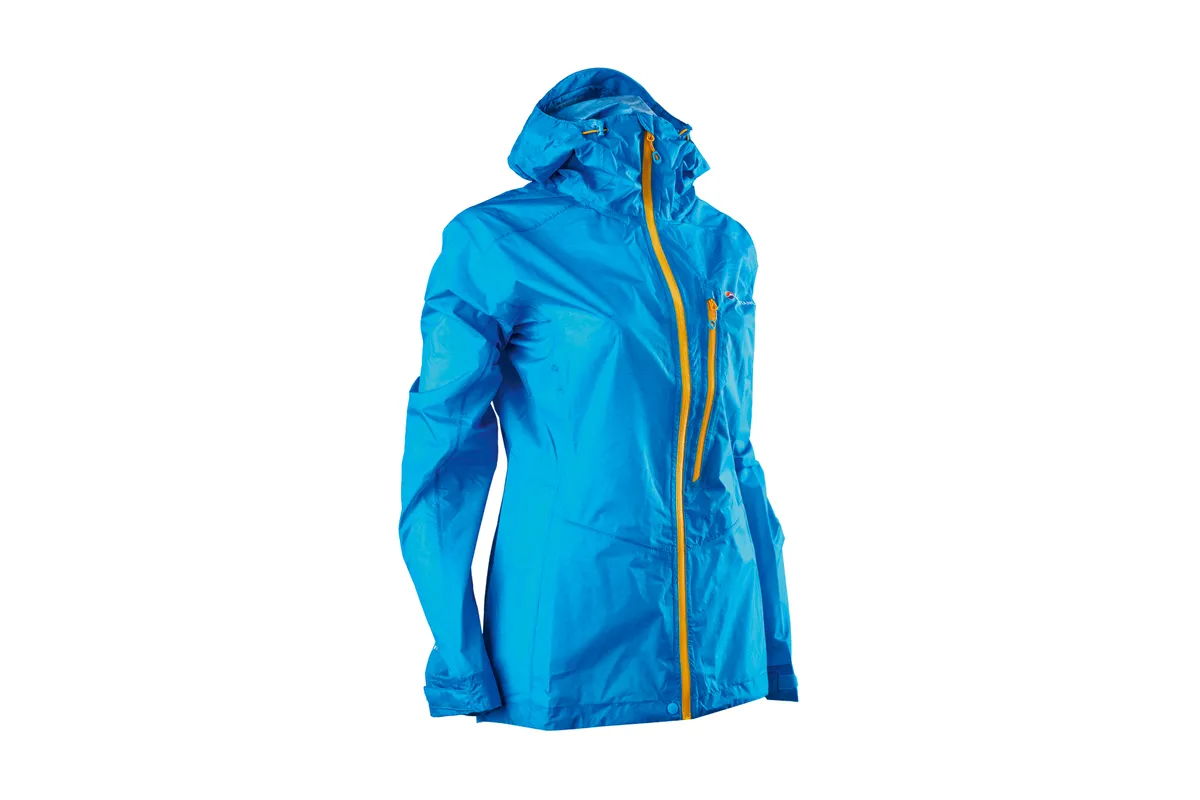
- £165
At 170g this jacket from Montane’s wide range is light, plus the zippy chest pocket (which is the perfect size for a mobile phone, though Montane quote it as ‘map sized’), also has a double-sided zip meaning you can turn it inside out and pack the jacket inside.
The Minimus uses Montane’s Pertex Shield fabric with taped seams, which did a brilliant job of keeping us dry in even the heavier winter showers, while a storm flap behind the zip prevented water ingress.
Soft fabric at the top stops it rubbing on the chin and the jacket was breathable. We did find the close female-specific fit on this jacket a bit tricky – a UK12 was too small on the hips, while a UK14 felt baggy overall.
Less curvy runners may find it suits them better, though a wider hem with more adjustability (you do get a drawcord) would give wider appeal. A wire peak on the hood along with an adjustable cord make sure the hood stays in place, plus you get reflective details.
Verdict: Faultless tech in the waterproofing, but fit doesn't suit this tester.
Score: 86%
Alpkit Gravitas
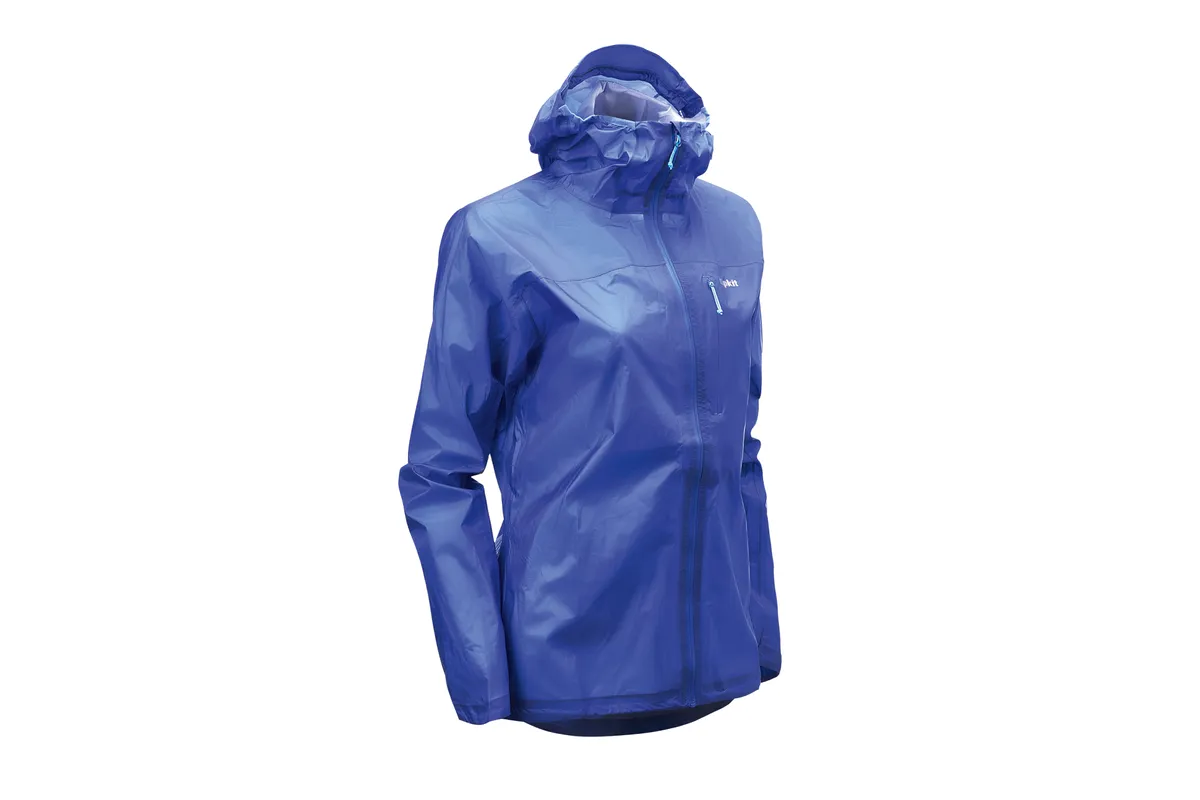
- £179.99
In a sea of muted blues and greens (we didn’t plan that!) this brighter ‘Fontainebleu’ option instantly put a smile on this tester’s face, something that carried through into testing too.
At 185g it is lightweight and felt barely-there, with very little rustling. The features include a large pocket on the front (though Alpkit advise caution, as they cannot guarantee waterproofing) and a wire peak on the hood, albeit with a nifty elastic adjuster and toggle on the top here, which allows you to pull the hood back to stop it obscuring your vision.
A hood stow tab also offers an easy way to roll it up when not needed. Cuffs are not adjustable, though an elasticated portion worked well and made them easy to push up if we got too warm.
The waterproofing was excellent with Alpkit’s highly breathable and waterproof (and recycled!) fabric doing an admirable job of keeping us dry. Taped seams and a storm flap behind the zip also feature, plus a stuff sack.
Verdict: This was one jacket that we enjoyed using every time.
Score: 88%
Finisterre Rainbird
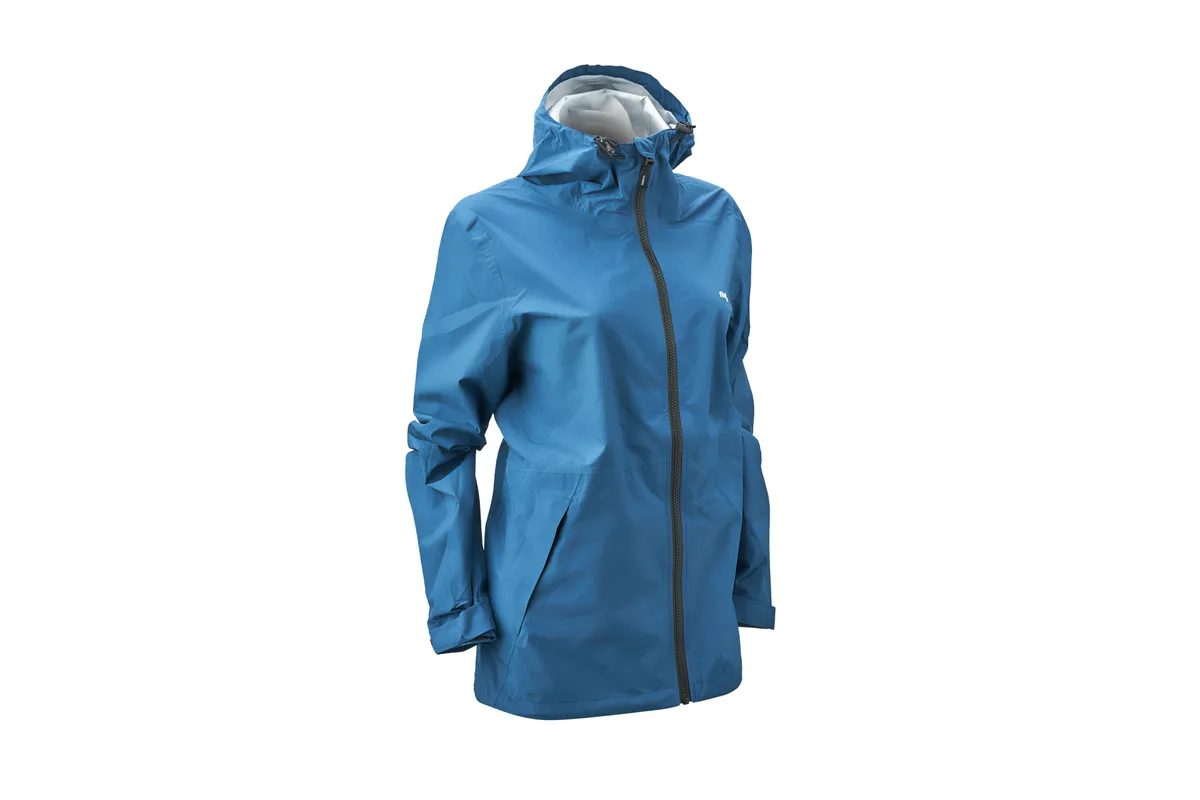
- £125
Built from 100% recycled fabric with eco-friendly, flurocarbon-free waterproof coating, the Rainbird has the kind of credentials you’d expect from B-Corp pioneers Finisterre.
Out on our test runs it kept us dry in both light and heavy showers, while breathability was excellent. Taped seams and a waterproof zip with storm flap and soft-touch fabric on the top added to the snug, dry feeling.
Large pockets with flaps were a good size for essentials, while toggles and draw cords at both the hem and around the hood allow for good adjustability, and once drawn in the hood was a snug fit around the face.
Like the Montane, Velcro on the cuffs allows the sleeves to be adjusted and prevents water ingress on the wrists.
The little bit of stretch in the fabric was appreciated and the jacket felt high quality, while the microporous inner film did a good job of wicking away sweat. Five women’s and seven men’s colours are available.
Verdict: A technical jacket with eco-credentials and a reasonable price point.
Score: 88%
2XU Light Speed WP Jacket

- £200
This being the spendiest option on test in our women’s category (by £20) we had high hopes of the 2XU – and luckily, it delivered (although as we went to print, like several other jackets on test, it was reduced – here to £140).
The fit was excellent, with our size large, for a size UK12-14 tester, having enough room to move while still being close enough not to feel flappy, helped by the fabric having a touch of stretch.
The peaked hood has a clever elasticated second layer inside which kept the rain off and also kept it in place, while a simple loop (the same as the Alpkit) allowed it to be rolled out of the way when not needed.
A single large pocket with zip and flap closure doubles as a stuff pouch with inner loop, while a single popper and tab across the chest allows the jacket to be done up and held while unzipped.
Waterproofing and breathability was superb, while air holes under the arms help keep things cool.
Verdict: A pleasure to run in; fast, responsive and great traction.
Score: 90%
Salomon Bonatti Trail
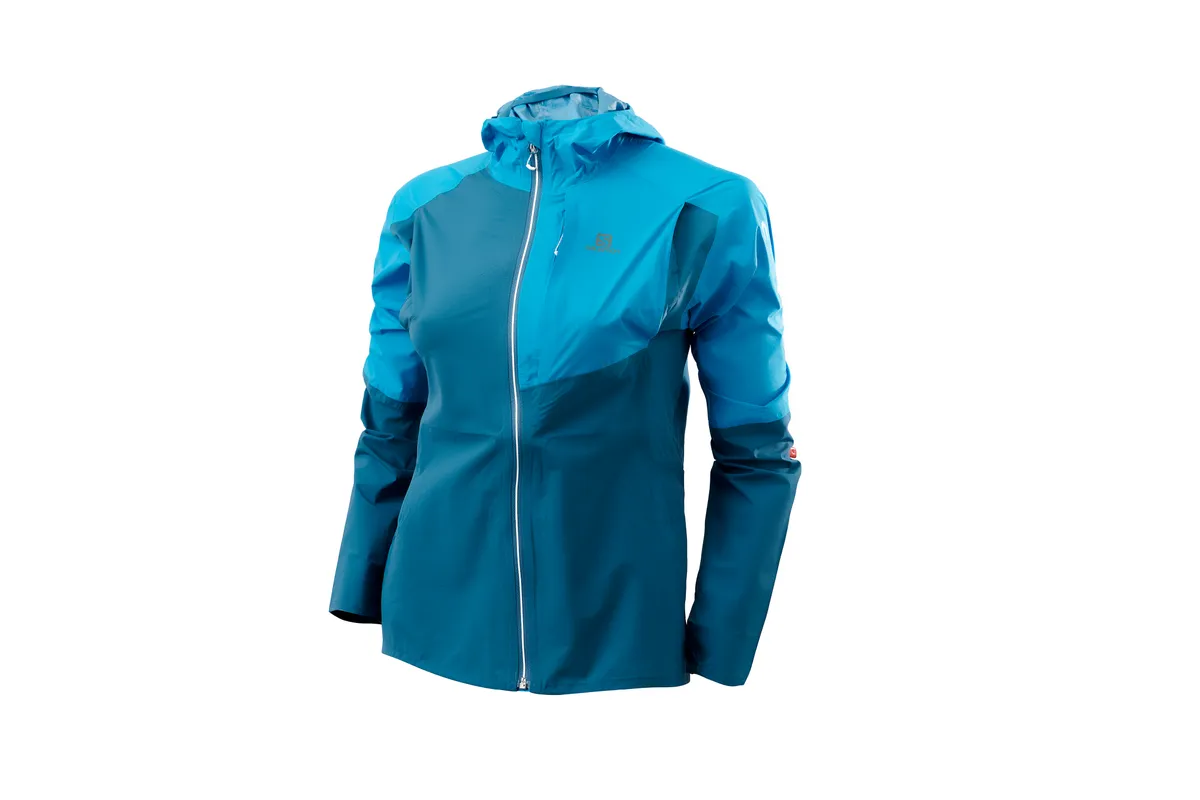
- £200
Light, breathable and packed with subtle features to set you up for a comfortable run, the Bonatti Trail is the priciest jacket in the women’s test.
So we were keen to test it to its limits in the torrential English rain and see if it’s worth the cash. Impressively, it does a great job fending off wind and rain, even in sustained, heavy downpours.
It fits well, too, with a secure hood, elasticated cuffs, waist adjustment and a drop tail at the back. Meanwhile, a press stud fastener behind the zip allows you to keep the zip open while maintaining weather protection, which is great for ventilation.
At 167g (UK small), it’s light, portable, and packs neatly away into the only zip pocket on the chest when not in use.
Verdict: High quality, weatherproof and completely reliable.
Score: 94%
Omm Halo
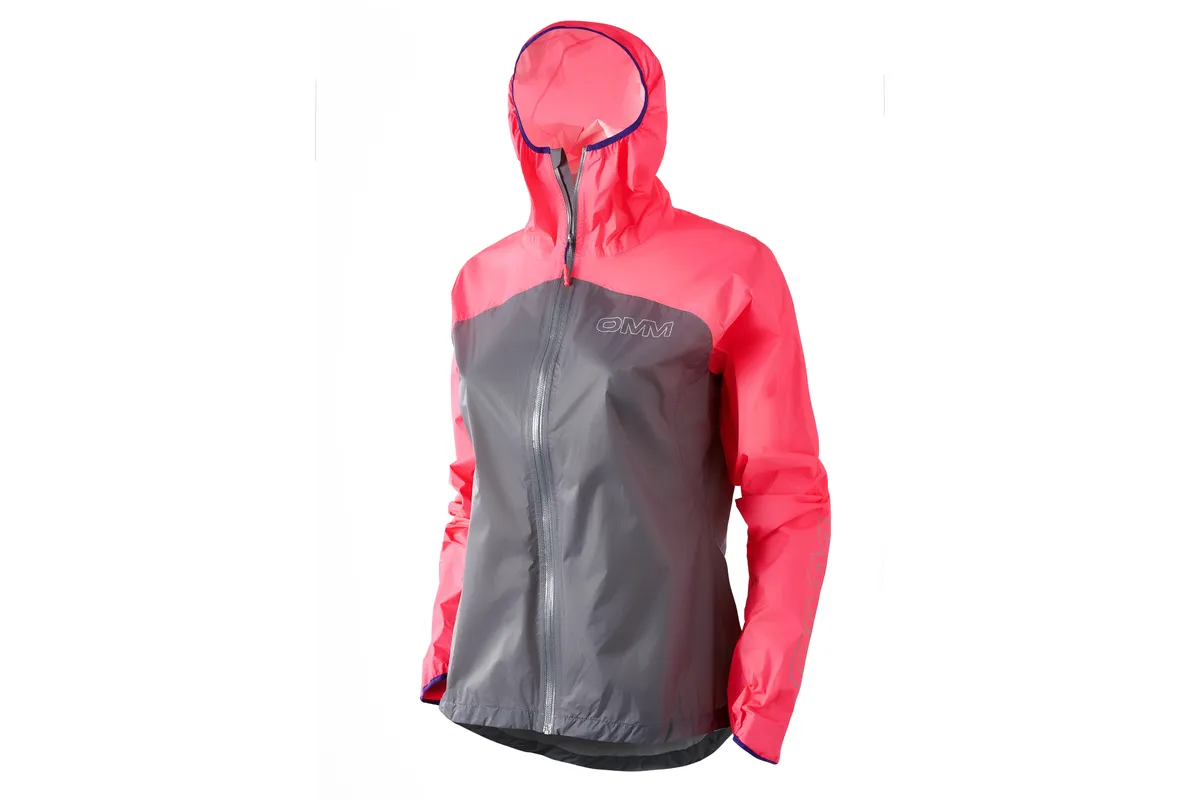
- £100
Designed to pack up small and weighing just 99g, this jazzy jacket boasts taped seams and two-layer 10,000mm HH fabric to keep us bone-dry in heavy downpours, while the female-specific fit and dropped hem are nice touches for keeping our bum dry.
It felt less warm than the Montane or Inov-8 and is also the only jacket on test to make a rustling noise as we ran – you don’t really notice it so much in rainy conditions.
There are no pockets and the hood isn’t adjustable, but it fits snugly round the head with an elastic peak and elastic cords adjust the hem and it meets all the requirements for essential race kit.
Grey and grey/purple colourways are also available if pink isn’t your thing, although we liked the touch of neon pink for safety.
Verdict: No-frills design for when functionality is key.
Score: 85%

